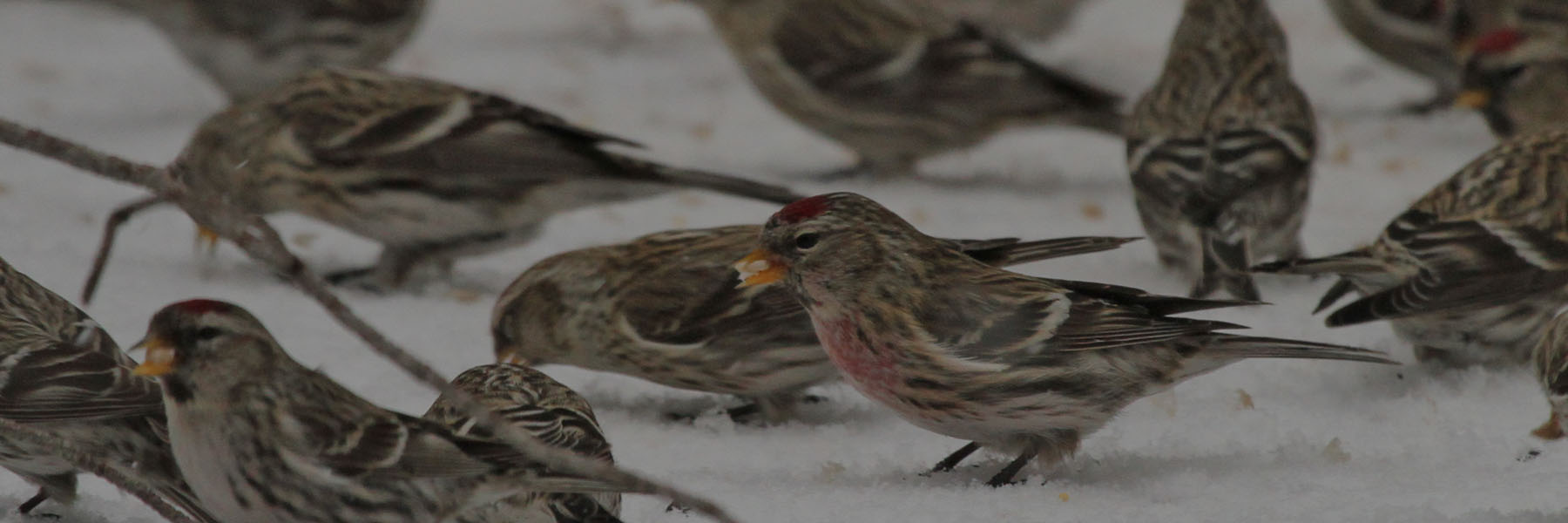A Quick Lesson on Eastern Finches
10 CommentsI have finches on my mind because I had two special visitors to my yard this week – Pine Siskins and Common Redpolls. These species are not always in my area, but will find their way further south during irruption years. Irruptions occur when there is a lack of food in the birds’ normal wintering grounds. They can be easily overlooked if you do not know what to expect. A Siskin can be mistaken for a Goldfinch, a Redpoll for a House Finch. If you see these birds, do you know what to look for?
This blog will show you some simple differences between some of the finches found in northeast Pennsylvania. I’m not very technical when it comes to bird identification so this post is put together through my own observations. I’ll start with a compilation of frontal views of the birds I will discuss. Do you think you can name them without looking at the answers?

The answer key for these finches is at the end of this post.
A very common backyard bird is the House Finch. They are mostly brown finches with streaking on their stomachs. The males have red on their faces, chest and rump.

Two male and one female House Finches
A similar species to the House Finch is the Purple Finch.

A female Purple Finch with a male in the background
They almost look the same! Let’s take a closer look at the males and females of these two species, starting with the males. Male Purple Finches have bolder markings on their face, more coloring on their wings and their bellies have a lot less brown streaking (if any at all). They usually seem to be a much brighter raspberry color than the House Finches, though that is not a good field mark since some House Finches can also have brilliant coloring.

Male Purple Finch
The duller male House Finches can be pretty easy to differentiate from the male Purple Finch. Their color can also vary from red to orange to yellow.

Male House Finch
Some House Finches can be very bright and are confused for Purple Finches. The best way to determine that it is not a Purple Finch is by the brown streaking on the belly and lack of red on the wings and back.

Male House Finch
Now lets look at some females. The female Purple Finch also has very bold markings on her face. This is probably the best way to tell them apart. She also lacks any streaking under her tail, unlike the House Finch, but that can be more difficult to see.

Female Purple Finch
The female House Finch lacks the strong facial markings. The streaking on her underparts is also a bit thinner than the Purple Finch. She also seems more brown overall (to me, at least).

Female House Finch
Moving on to another bird that many people know – the American Goldfinch. In breeding plumage, the male Goldfinch is unmistakable with his bright yellow body, black cap and wings.

Male American Goldfinch in breeding plumage
The female is also very bright in breeding plumage, but she lacks the black cap and has duller wings. Still, she is an easy bird to identify.

Female American Goldfinch in breeding plumage
This bird loses and replaces it’s bright colors with more drab yellows and browns every fall. This is what the same bird looks like during the fall and winter months.

Male American Goldfinch in non-breeding plumage

Female American Goldfinch in non-breeding plumage
Insert some winter visitors into the mix. The two more common winter visitors where I live are the same size as the Goldfinch and I often see them flocking together around food sources: Pine Siskins and Common Redpolls. These birds typically only show up during irruption years.
Pine Siskins have brown streaking with subtle yellow markings around the edges of their wing and tail. They can be very easily confused with female House Finches, especially if the yellow is not very apparent. A huge key difference in the species are wing bars and the long, slender bill.

Pine Siskin
The yellow is more easily seen when the bird flashes its tail or wings.

Pine Siskins flashing their yellow
Some of them do have more noticeable coloring while perched. There is also a small percentage of them are the more extreme-colored green-morphs.

Green-morph Pine Siskin
Common Redpolls, on the other hand could be confused with Siskins at a distance or male House Finches at a quick glance. They have brown streaking and a short, slender bill. Males have red coloring on their chest and upper flanks.

Male Common Redpoll

Female Common Redpoll
There is also the rare Hoary Redpoll that can visit over the winter months. This bird is much more pale than the Common Redpoll, the streaking is fainter and the bill is smaller. The males have an even slighter hint of red on the chest.

Male Hoary Redpoll
Here is a [poor] photo of three of these birds at my feeder at the same time.

Pine Siskin, American Goldfinch and Common Redpoll
They are about the same size but when they are together, you can see the differences very easily.
Think you have a handle on it? Here are a few photos of some of these birds side-by-side. Can you determine who is who without looking at the answer key?

What species of Finch are these?

Who are these male birds?

These are fledglings of two of the birds in this post. They look like the females of the species.
How do you think you did? I hope my basic lesson on these birds helped you figure out which species these birds are.
Answer Key:
Top photo: from top left to right: American Goldfinch, Pine Siskin, House Finch (male); from bottom left to right: Purple Finch (female), Common Redpoll (female), House Finch (female)
Bottom photos: first photo: House Finch (female) and Pine Siskin; second photo: House Finch (male) and Purple Finch (male); third photo: House Finch (juvenile) and Purple Finch (juvenile). Yes, I did put all of the House Finches on the left side on purpose.

